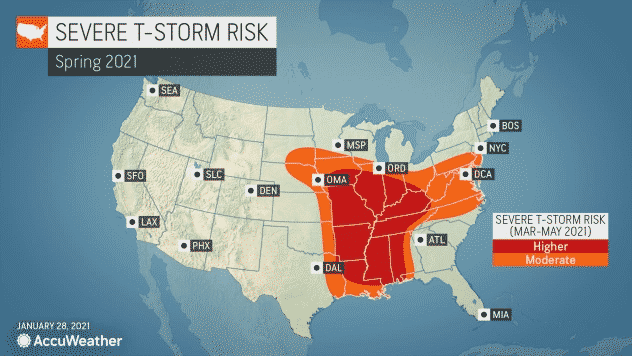AccuWeather meteorologists are calling for a slow start to the peak of the severe weather season across the United States this spring, and they are warning of the possibility that severe weather and tornado activity could abruptly fire up and rival one of the most notorious severe weather seasons ever, due to some atmospheric similarities current weather patterns bear to that devastating season.
In addition, one area of the country that accounts for only a small fraction of tornado activity could be at risk for more severe weather than usual this year. All of those factors and much more are covered in AccuWeather’s annual U.S. tornado forecast, a comprehensive look at what the long-range forecast team expects in terms of the number of tornadoes predicted to occur throughout the year and places that are at risk of getting the most action.
In recent years, the severe weather and tornado season has kicked off earlier than usual. Severe weather can occur during any month of the year, but the peak activity usually falls during the months of March, April and May. Storm chasers tracked robust thunderstorms across the Plains during the middle of winter and into the beginning of spring in 2020.
“The last couple years, it was an early start to tornado season,” Extreme Meteorologist Reed Timmer said in AccuWeather’s spring preview. “We were already chasing during parts of January last year. That’s because there were El Niño conditions in the tropical Pacific, so we had a very energized southern stream to the jet that was pumping moisture, bringing with it disturbances as well, early on in the year. And that’s why we were chasing in January, February and then again in March.”
There was another key factor to last year’s early onset of severe weather, AccuWeather Lead Long-Range Meteorologist Paul Pastelok added. “There was a lack of true Arctic, stable air in mid- to late winter last year,” he said — something that certainly hasn’t been lacking this winter.
However, this spring is forecast to play out differently with a La Niña pattern that is expected to continue and influence weather patterns across the globe. La Niña patterns are characterized by strong northern branches of the jet stream. Some noteworthy historical seasons for severe weather have been shaped by such patterns, but not all La Niña years are exactly alike, and other factors need to be taken into account, AccuWeather meteorologists explain.
“The temperature of the water in the central and eastern Tropical Pacific during February 2021 is similar to the La Niña pattern in February 2011,” Pastelok said. Water temperatures in mid-February in those parts of the Pacific Ocean ranged from 73-81 degrees, about 1-2 degrees below normal for this time of year, according to the World Meteorological Organization. Those water temperatures are expected to remain below normal through March, which will allow the La Niña pattern to persist into spring.
“[The spring of 2011] was one of the most active springs in recorded history, especially April with over 700 tornadoes, but it was a later start to that tornado season,” added Timmer. “During February and March of that year, everyone was wondering if it was going to be a very below-average year and then the bottom dropped out in April.”
Similar to 2011, the start to severe weather season may be slow to develop across the United States then turn more active by April and May.
Despite the slow start to the season during late winter, recent clashes of the bitterly cold air accompanying cross-country winter storms and warmer air to the south have set the stage for destructive and even deadly tornadoes.
On Sunday, Feb. 14, an EF0 tornado ransacked a retirement community in the Tampa area. Just one day later, an EF2 tornado touched down in Damascus, Georgia, on Monday afternoon. Another tornado claimed at least three lives as it charged across parts of Brunswick County in southeastern North Carolina, inflicting serious damage along its path, early Tuesday morning.
As of Feb.16, the Storm Prediction Center (SPC) reports that 23 tornadoes had touched down so far in 2021. On average, 64 tornadoes occur during January and February in the U.S.















